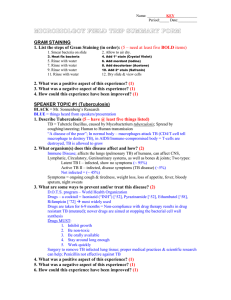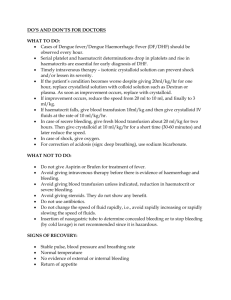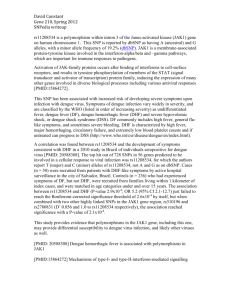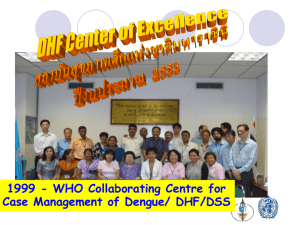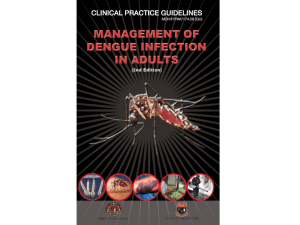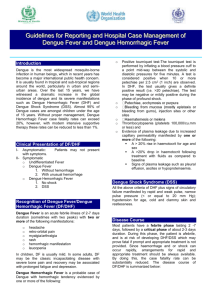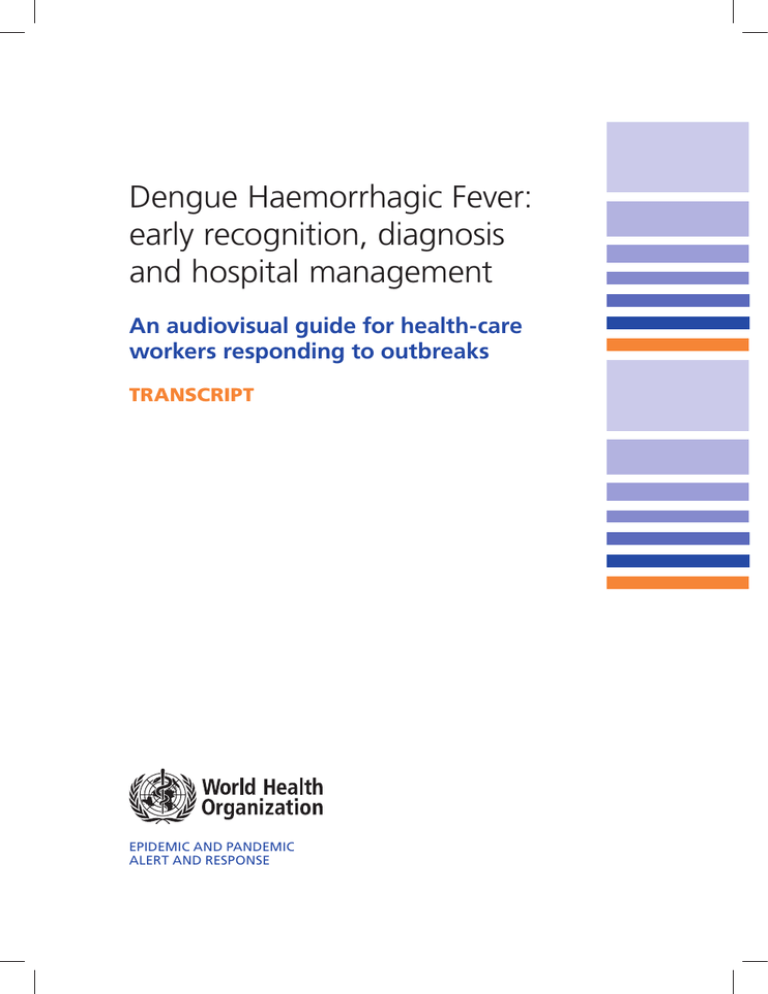
Dengue Haemorrhagic Fever:
early recognition, diagnosis
and hospital management
An audiovisual guide for health-care
workers responding to outbreaks
Transcript
Epidemic and Pandemic
Alert and Response
© World Health Organization 2006
WHO/CDS/EPR/2006.4a
All rights reserved.
The designations employed and the presentation of the material in this publication do
not imply the expression of any opinion whatsoever on the part of the World Health
Organization concerning the legal status of any country, territory, city or area or of
its authorities, or concerning the delimitation of its frontiers or boundaries. Dotted
lines on maps represent approximate border lines for which there may not yet be full
agreement.
The mention of specific companies or of certain manufacturers’ products does not
imply that they are endorsed or recommended by the World Health Organization in
preference to others of a similar nature that are not mentioned. Errors and omissions
excepted, the names of proprietary products are distinguished by initial capital letters.
All reasonable precautions have been taken by the World Health Organization to
verify the information contained in this publication. However, the published material is being distributed without warranty of any kind, either express or implied. The
responsibility for the interpretation and use of the material lies with the reader. In no
event shall the World Health Organization be liable for damages arising from its use.
Designed by minimum graphics
Preface
Epidemic dengue/dengue haemorrhagic fever (DHF) is a major public
health problem in tropical and sub-tropical countries in South-East
Asia, Western Pacific, Latin and Central America. An estimated
500 000 cases of DHF require hospitalization each year, of whom a
very large proportion are children. Without proper treatment, DHF
case-fatality rates can exceed 20% but with modern intensive supportive therapy, such rates can be reduced to less than 1%.
This CD-ROM1 has been developed to train health-care workers to
recognize the clinical features and early warning signs of DHF, to initiate prompt referral, and to follow the principles of advanced hospital
supportive care in order to reduce case-fatality rates.
Of crucial importance is the recognition and management of capillary leak for which conventional paediatric resuscitation protocols are
often inadequate or potentially harmful. The film emphasizes not just
“what to do” but also “what not to do” as well as “warning signs to
look for, and when”. In January 2005, Timor Leste faced an outbreak
of DHF when the case-fatality rate peaked at around 14%. In Timor
Leste, these management measures helped local staff successfully
reduce the high case-fatality rate.
This booklet contains the transcript and timing of the film narrative to
facilitate translation into other languages.
1
The film was taken at the National Government hospital (NHGV)in Dili during the
WHO coordinated GOARN response. GOARN: Global Alert and Response Network.
Acknowledgements
Video footage for the CD-ROM was obtained with the cooperation of
the DHF patients, their families and the staff of the National Government Hospital (NHGV) in Dili during the WHO coordinated GOARN
response to the 2005 dengue haemorrhagic fever (DHF) outbreak in
Timor Leste. This CD-ROM and transcript have been developed by
experts from the WHO Collaborating Centre for Case Management
of Dengue/DHF in Bangkok, Thailand, the WHO Country Office in
Dili, Timor Leste, the WHO Regional Office for South-East Asia, New
Delhi, India and the WHO Department of Epidemic and Pandemic
Alert and Response in Geneva, Switzerland.
Transcript of the DHF training film
AUDIO
VIDEO
This child is suffering from dengue
haemorrhagic fever (DHF). His capillaries
are leaking fluid and he has a tendency to bleed. This is what distinguishes DHF
from dengue. It is a painful disease which
can cause severe bleeding, and if not
treated properly and timely, often results
in death.
00:12
Child showing
signs of DHF
But the problem of treating DHF does not
start here on the ward, it starts much
earlier wherever patients are first seen.
00:35
View of paediatric
and emergency wards
All health-care workers need to know
how they might suspect a diagnosis of
dengue and know how they and the
parents can treat mild symptoms and be
on the lookout for signs of DHF, especially
the signs signifying the need for admission
and careful treatment.
00:45
If you are in a dengue-affected area you
should suspect dengue fever if you
recognize one or more of the following symptoms:
01:07
Map of dengue
affected areas
•
01:19
Child with fever
Fever pattern: an abrupt onset, high
fever, and sometimes a saddleback fever, a fever that does not completely respond
to paracetamol syrup.
• Symptoms of headache, retro orbital
pain, muscle pain, and joint pain.
01:30
Child in pain
AUDIO
VIDEO
• A child may appear physically tired or have other altered behavior, for example irritability or vomiting.
01:40
A quiet child
•
01:50
Pictures of various
children with these
symptoms
Skin may show signs of a flushed face
or there may be erythema or maculo-
papular rash on the head and trunk
region of the body.
If you suspect dengue, then the next step
is to look for risk factors or features of DHF.
Increase in size and the tenderness of the
liver might also suggest DHF.
02:11
Doctor examining
child
Distinguish the symptoms from other common illnesses such as measles or malaria.
02:21
Doctor questioning
mother
Laboratory tests compatible with DHF are:
• decrease in white cell count;
• decrease in platelet count; and
• increase in haematocrit.
A blood film may also show atypical lymphocytes.
02:31
Health-care worker
making a blood film
and performing the
haematocrit test
A specific test for DHF is the tourniquet test. This is done by first measuring the blood pressure. Remember to use a blood pressure cuff the right size for that child.
02:51
Nurse performing
the tourniquet test
Then inflate the cuff to a pressure exactly half way between systolic and diastolic
pressures.
03:04
AUDIO
VIDEO
Now keep the pressure inflated for 5 minutes.
03:11
After releasing the cuff look carefully for small red or purple bleeding points in the
skin known as petechiae. These might be
tiny, the size of a pinhead. If there are
10 or more bleeding points in 1 square
inch area, then the test is positive.
03:15
But remember, the tourniquet test can be negative especially early in the disease or in obese patients or in patients with shock.
03:39
Graphic with list
So, if there is any suspicion of dengue or DHF here is:
What to do
What not to do
The warning signs to look for and when
03:49
Graphic with list
What to do
Bring the temperature down. Whatever the cause of fever, a very high temperature can be dangerous and can cause fits known as febrile convulsions. To bring down high
fever to below 39 °C, gently sponge the
child with clot soaked in water and give
paracetamol.
04:02
Child being
sponged to bring
down the fever
Maintain hydration and electrolyte balance 04:24
using oral fluids. Thirst is common but many Child drinking avidly
children need help to drink. Avoid giving from a bottle
only water as this will not replace lost
electrolytes. Continue breast feeding if
possible.
AUDIO
VIDEO
Keep mosquitoes away, for example
using nets, to stop spread of the disease from a person with dengue. Remember unlike malaria, the mosquitoes that spread dengue will usually bite during the day.
04:42
Child under a
mosquito net in
the paediatric ward
What not to do
Avoid certain drugs, for example, aspirin, NSAIs (non steroidal inflammatory drugs such as ibuprofen) which in this child leads to bleeding.
04:59
Child with aspirin
related epistaxis in
the emergency ward
Avoid inappropriate intravenous (IV) fluids. Always use oral fluids if the child is able to drink.
05:12
Child drinking
In DHF, if IV fluids are given when not necessary or too quickly, the extra fluid can pour out of the leaky capillaries into the
tissues.
05:19
IV Drip
You may see this as puffiness around the eyes, or even abdominal distension due to fluid in the peritoneal cavity.
05:29
Child with puffy eyes
But most importantly fluid easily leaks into
the pleural space causing pleural effusions and by pressing on the lungs this makes
breathing difficult.
05:37
Child breathing fast
Here is a chest X-ray of a child with pleural 05:48
effusions. Because the child was lying down Chest X-ray
when the X-ray was taken most of the fluid
just shows up as diffuse hazy shadowing
behind the lungs, but the arrows show where the fluid is also pressing on the sides
sides of the lung. AUDIO
VIDEO
The wrong kind of fluid, for example, too
much 5% dextrose on its own without any
balanced salt solution, can also cause
problems such as convulsions due to brain
edema or swelling.
06:10
IV Drip
The warning signs of what to look for and when
Parents as well as health-care workers need
to know these as most of them signify the
child needs admission to hospital. It is
important to remember that the risk period
is especially high in the first 1–2 days after
the fever subsides. This is known as the
critical period.
06:28
Mother holding child
The warning signs include:
• Refusing to accept oral fluids or vomiting.
• Sleepy or restless child.
• Bleeding, especially gastro-intestinal
bleeding with fresh or old blood in the
vomit or stool. Old blood in the vomit
looks like coffee grounds; in the stool
it may resemble thick black coal tar.
• A child suffering from abdominal pain.
• Skin mottling, cold sweaty skin or cold
hands and feet.
• Absence of urine in the last 6 hours.
06:53
Children with the
different warning
signs of DHF
AUDIO
VIDEO
In addition to the above, doctors or
nurses should also measure:
• Capillary refill time (CRT)
• Heart rate
• Respiratory rate
• Blood pressure
07:55
Graphic with list
Of all these a capillary refill time of more
than 2 seconds, as shown here, is especially easy to detect.
08:10
Doctor checking
CRT
If all the points we just talked about are
absent the child may be sent home with careful advice to parents to remember:
• What to do
• What not to do
• The warning signs to look for and when
08:20
Child leaving
with parent
08:34
If there are any concerns or if the parents are unable to comply with these instructions, Hospital entrance
then consider admitting the child.
Early signs of shock or significant bleeding need urgent referral to hospital. In DHF, although a child may appear to initially survive a period of prolonged shock,
haemorrhage will often become severe and
other complications such as renal failure can
develop. It may also be difficult to reverse.
08:43
Child with
haemorrhage
A paediatric ward provides frequent and skilled observation and immediate expert management of these complications.
09:07
Doctor examining
child
AUDIO
VIDEO
Remember that the risk period is especially high during the first 1–2 days after the fever subsides. This is known
as critical period. It is during this phase
that capillary leak can be severe. Plasma leakage is the most important feature
of DHF and often precedes bleeding. This
is a feature that needs special monitoring.
09:14
Child in critical stage
A centrifuge and capillary blood tubes provide the most essential and frequently
performed test with immediate results. As the capillaries start to leak plasma, the
remaining red cells become more
concentrated. DHF frequently shows a rise
in haematocrit of 20%, that would be a
change in haematocrit for example from
35% to 42%.
09:39
Nurse using
centrifuge for
haematocrit
Here is a visual demonstration of what happens when the haematocrit changes.
10:11
Graphic
As the plasma level falls the haematocrit rises sharply as there is not enough fluid
demonstration in proportion to the red cell.
10:23
Visual demonstration
Chest X-ray
Remember if IV fluids are given when not
necessary or too quickly, the extra fluid can
pour out of the leaky capillaries into the
tissues.
You may see this as puffiness around the eyes, or even abdominal distension due to fluid in the peritoneal cavity.
10:37
Child with puffy eyes
AUDIO
VIDEO
But most importantly, fluid easily leaks into the pleural space causing pleural effusions, and by pressing on the lungs this makes breathing more difficult.
Child breathing
fast.
Chest X-ray
During the capillary leak phase just enough fluid must be given to prevent circulatory shock. The paediatricians will refer to
published guidelines or wall charts to give exactly the right amount of fluid at this
critical stage.
11:05
Visual
demonstration
continued
A falling haematocrit could be a sign of bleeding. This is an important sign where bleeding is concealed. Sometimes bleeding into the gut may not be apparent, for
example until it passes out in the stool or
vomit. Remember this sort of bleeding can
be associated with severe abdominal pain.
11:29
Child with
haemorrhage
11:52
In children who are obviously recovering, fluid that leaked into the tissues, peritoneum Recovering child
or chest cavity will be reabsorbed and may
also result in a fall in haematocrit.
VIDEO
AUDIO
Remember nurses will still be observing children closely for any of the important warning signs
• A child refusing to accept oral fluids or vomiting
• Sleepy or restless
• A child suffering from abdominal pain
• Skin mottling
• Cold sweaty skin
• Cold hands or feet
• A reduced urine output
These are all signs of shock which may
require immediate increase in IV fluid.
12:07
Review of children
with the different
DHF signs.
Bleeding which may be visible or concealed may require urgent blood transfusion if severe.
12:51
Child with
haemorrhage
A child whose breathing is fast or requiring more effort may require oxygen therapy and immediate reduction in the
IV fluid.
13:01
Child breathing fast
In addition to these observations doctors or nurses will also monitor:
• Capillary refill time (CRT)
• Heart rate
• Respiratory rate
• Blood pressure
13:13
Graphic with list
In critically ill children, these observations might be necessary every half hour.
13:25
Child in critical stage
AUDIO
10
VIDEO
Features common in the recovery period which may support the clinical diagnosis of DHF are: a widespread itching rash
often with white centres, slowing of the
heart rate, but for definitive diagnosis,
blood samples should be taken.
13:32
Recovering child
Reporting of all cases must also occur to
ensure appropriate public health measures
can be started. Any deaths public health reporting from DHF should be examined closely. They often reveal the need for more resources or training. With constant
evaluation and feedback to all involved from
community to specialist hospitals more
children with DHF can be successfully treated and sent home. 13:53
Doctor and nurse
doing paper work
for public health
reporting purpose
14:14
Child goes home to
her family
14:26
Production Team:
Renu Dayal Drager
Graphic with text
Emma Fitzpatrick
Siripen Kalayanarooj
Simon Mardel
Nikki Shindo
Garrett Smyth
This film was made during the 2005 DHF outbreak in cooperation with patients
and staff of the National Hospital and the
WHO Country Office in Dili, East Timor.
GOARN and WHO logo
www.who.int/csr
WHO copyright text

